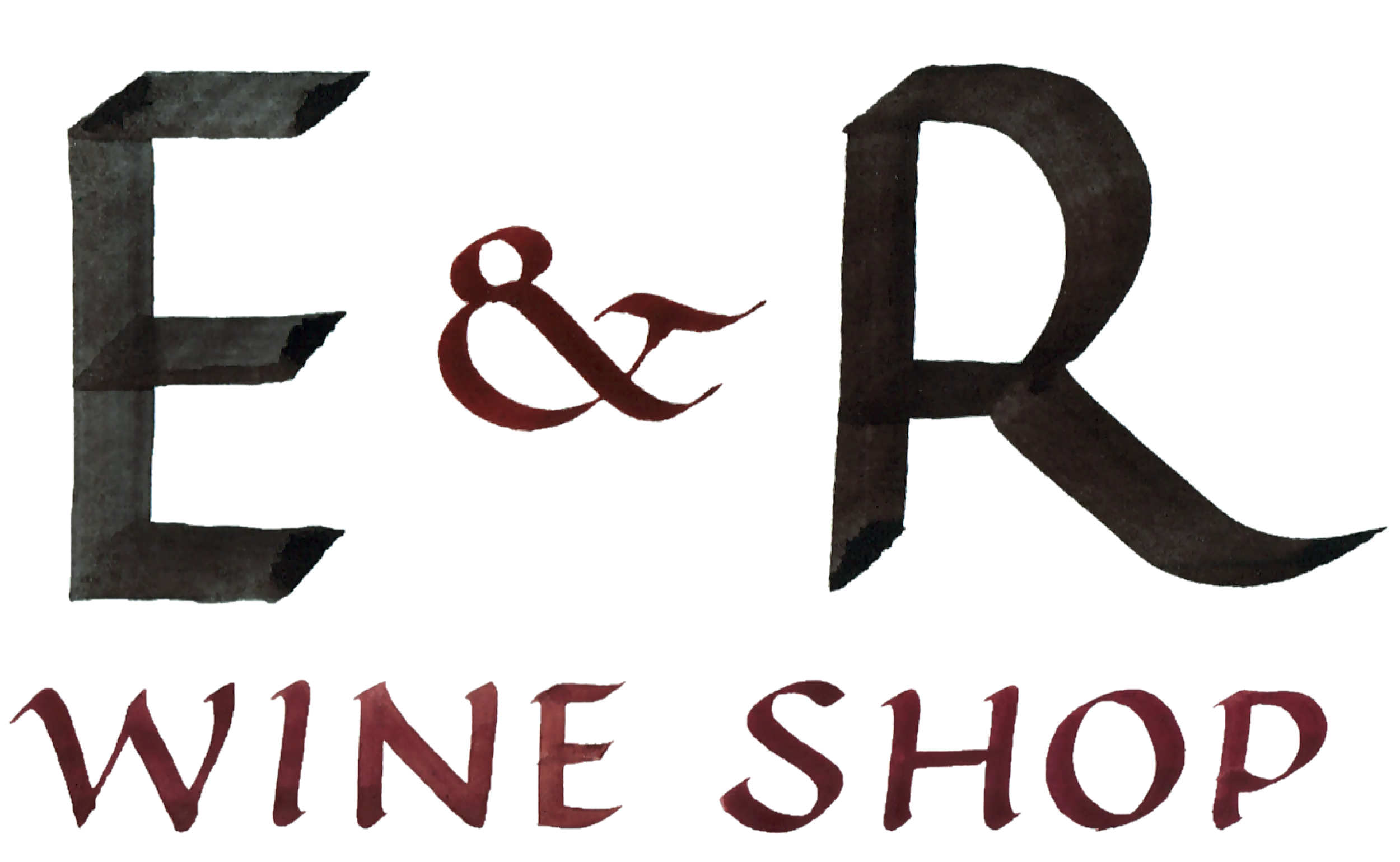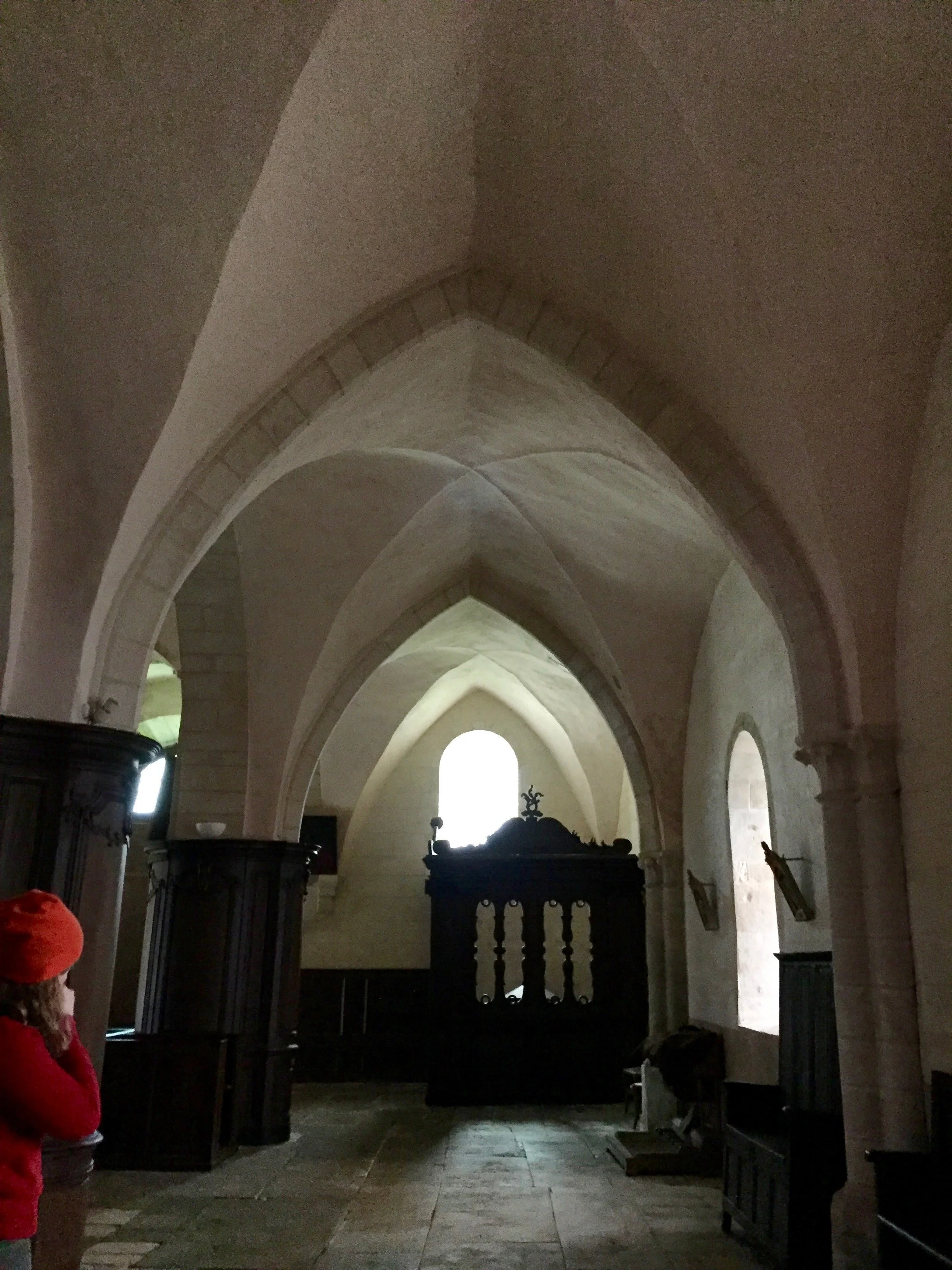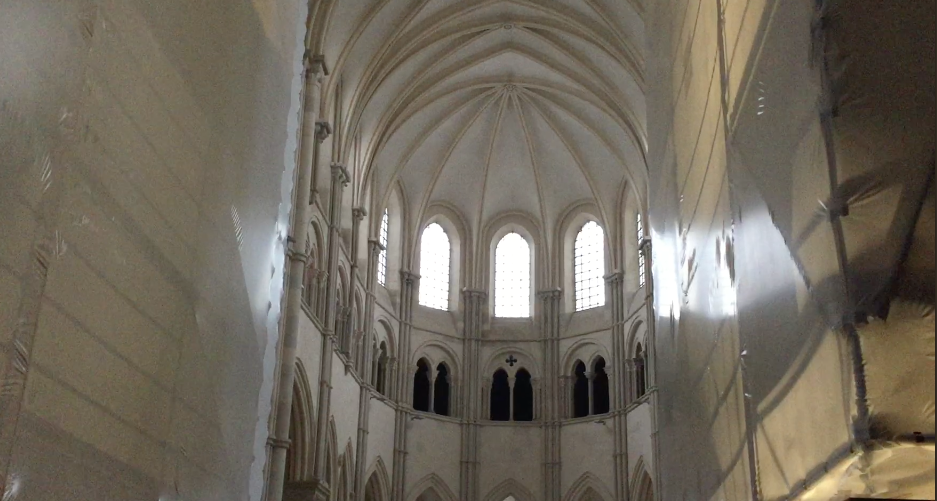Les Faverelles- Vézelay, France
(patrick of les faverelles)
(3/22/18. North of Beaune) Things were starting to wake up in Asquins. The lowered branch above the millstream had been strung with paper blossoms by someone too impatient to let spring have its way. Frenzy courses through our sense of humor in the springtime just as the sap rises in the vines, which left streaky stains on the pruners’ shears throughout Burgundy that morning.
I was on my way to go see Patrick Bringer at his winery, Les Faverelles, in Asquins. The wines had been a memorable discovery of mine in the months since I started working at the shop here at E&R. Only a few bottles remained on the shelf from the last shipment. Each time I would set to organizing the Burgundy shelf (a task I love), surely a bottle of Les Faverelles would sing out to me and inevitably be opened at my house that evening. The charm of Les Faverelles was the fantastic price — thanks to our Almost Direct Imports program —around $25 for both the red and the white. And the rarity of the words, when spoken almost like an echo in a seashell. Vézelay. Where’s Vézelay?
Oh, at those prices it could have not mattered, but it really does: Burgundy. Vézelay is a medieval village located in the Yonne department of Burgundy, up in the north. It’s just around the corner from Chablis, verging on the Morvan nature park. Like Chablis, Volnay, Pommard, etc, Vézelay is a village appellation of Burgundy. Even on that spring day, just one or two days after the vernal equinox, I was struck by the plush new growths of springtime. In comparison to Chablis (whence I had driven that morning), the villages and vineyards were more interspersed with meadows and forests. To compare distance, the drive from Beaune to Vézelay is about the same in time as it is from Portland to Hood River, and the climate differences are just as stark. Vézelay is colder and consistently produces lower-alcohol wines than its counterparts in the thick of Burgundy.
What do we expect of an appellation like Vézelay that skirts the geographical boundaries of a greater region? There’s familiarity in the varieties of grapes they grow: pinot noir and chardonnay. But sometimes, we expect a wine that comes from the outskirts of a region to be lesser in quality. Not so with Les Faverelles. Patrick and Isabelle Bringer left a busy life behind in Paris with purpose, to seek solitude and to focus on the task of making wine. While there may be more prestige in the inner sanctum of Burgundy, there is as much attention in these outskirts. With just 70 hectares of land under vine, and most of the growers in the area working organically, Vézelay has the whiff of something ancient. Not to mention the cathedral up on the hill dating to 1058.
Click images to enlarge
Back in Asquins, Patrick Bringer was inside blasting Diana Krall. I could hear it from behind the arched lavender door under the still-wintry wisteria vine. I rang the bell, and at my service was a wise soul with a knowing presence: Patrick Bringer. It wasn’t easy to know him, though. His mustache was so large that it covered his lips and further obscured his words. I attempted to speak and listen with my very rouillé (rusty) French, and Patrick was patient in speaking slowly. He kept his words few, but managed to communicate a multitude. Of course, as we all know, good wines are good communicators. Everything unfolded when the bottles were uncorked. The apparent disarray of the room dissolved and there was just us and the wines.
Patrick left behind a career as a bookseller in Paris to make wine. That was 20 years ago, in 1998. Since the beginning, it was important to Patrick that the farming be organic. Then, in 2003 he and Isabelle transitioned to bio-dynamic agriculture. The duo farm 6 hectares of land, split between pinot noir and chardonnay in equal parts. Official appellation rules say that Vézelay is for white wines, so the red wines are labeled "Bourgogne rouge". Their vineyards benefit from the Jurassic period Bathonian soils — a combination of clay and limestone.
When you’re reading a really great novel you are at the mercy of the author, though you can do things to help her be more understood. We like to think that Patrick Bringer's commitment to organic/bio-dynamic farming, combined with his minimalist approach in the cellar (native yeasts, no filtration or fining, only old oak barrels and stainless steel) are a humble attempt to listen better to what old Vézelay, wants to say, in all of its medieval, green, cloudy, slightly dreamy ways. His cellar and production facility are tiny and cluttered, and he doesn't want to make any more wine than he does. One of the only things he said clearly in English to me was "I don't want to retire." He's found the intersection of exactly what he wants to do and how much he can do and he's doing it, beautifully. We will take as much as we can get.
Click images to enlarge
(the tasting)
After we tasted with Patrick at Les Faverelles we went in search of the ancient church. Prior E&R visitors to Vézelay had mandated the visit, saying it was one of the great churches of Europe. So we snaked through the tight cobbled streets of Asquins up the hill to a modest, but very old stone church. I repeated to my traveling companion — this is one of the great cathedrals of Europe! I felt like Don Quixote, seeing giants where there were windmills, because it just had none of the grandiosity I was promised. It was pretty and old with lovely whitewashed insides and stained glass windows and when certain beautiful voices sang within, it was exquisite. Later I would learn there was a relic of St. James in the church and that it was a UNESCO heritage site, and one place to hop on the Compostela pilgrimage route. But there were no stories-high vaulted arches, no intricate stone carvings, just an empty village church. Any intricacy to be found was in just being there. We laughed it off, got back on the road to Vézelay proper and the Vézelay abbey. Yes, the facade was grand, but if the acoustics were grand we couldn't have known for the scaffolds of construction going on inside the nave. The bones of Mary Magdalene are in a relic in the basilica of the abbey. It was eerie to see them entombed with the echo of construction above. Give me the still village church over the clatter of the famous places any day.
The wines are compelling and quiet. Each one of the wines presents itself broadly, with ripples of life under the surface inviting conversation and deeper engagement. Like the simple whitewash walls of the church in Asquins filled with a living, singing voice. The wines from Les Faverelles will have you forget any expectations that you might have about wine from an "outsider" location and provoke curiosity and joy. Vézelay is a place filled with hermetic winemakers rocking out to Diana Krall, churches grand and humble, and wines with a majestic twinkle in their eyes.
Click on each wine for more detail.
PREVIOUS WINES FROM FAVERELLES
2017 Bourgogne Rouge Nez de Muse
Nez de Muse was named for Patrick and Isabelle's dog, Muse, who apparently was one smart cookie. She followed her nose to the organic grapes, while rejecting those that had been treated with chemicals. The Nez de Muse grapes come from the top of a hill that is both limestone and clay, more limestone. Herbal, high toned, with lots of strawberry aromatics. Aged in neutral oak. Three cases!
2017 Bourgogne Rouge Pinot Déraisonné
Déraisonnér means to speak nonsense. So sometimes, the thing underneath that a winemaker strives to point towards isn't so serious. It's a giggle, not a big truth. Or is the giggle the big truth we want anyway? Certainly in more high-falutin' circles of Burgundy this wine might be laughable: 1ppm sulfur added just before bottling. The wine is not destemmed and fermented whole cluster, giving it a minuscule prickle like a young Beaujolais. But the Vézelay clay comes through with substantial volume. When tasting this against the Nez de Muse (which is still very low in sulfur, less than 40 ppm) there is a wonderful tonal depth, moving through red fruits like a cooked down broth. Although we have brought in previous vintages of other Les Faverelles wines, this is our first run with Déraisonné, though he has made it in 2011, 2014, and 2016. To prove the point that (nearly) zero sulfur wines have a life ahead of them, Patrick opened a bottle of the 2015 vintage of this wine during our tasting. It was absolutely gorgeous, packed with umami and fruit. Three cases of 2017.
2019 Bourgogne Vezelay Blanc Cuvée Fleur
Unbelievably dense year after year, but especially with the concentrated 2016 vintage. Perhaps the most emblematic of Les Faverelles winemaking style, with a strong, noble, truffle-y nose. 100% chardonnay, all destemmed and directly pressed into very old oak foudres. Like all of their wines, fermented with native yeasts, unfiltered, and low-sulfur. Patrick believes the single hectare Fleur vineyard may be Vézelay's finest parcel. Downslope from the Nez de Muse, there is more of the Vézelay red clay and less of the exposed stones and shells. In this cool northerly climate, the soil and exposition of the site help to build weight and structure in the wines. A handful of cases.
2019 Bourgogne Vezelay Blanc Cuvée Le Nez du Muse
The nose knows. Nez de Muse was named for Patrick and Isabelle's dog, who apparently was one smart cookie. She followed her nose to the organic grapes, while rejecting those that had been treated with chemicals. The Nez de Muse grapes come from the top of a limestone prominent vineyard, where the soil is more rocky and exposed. To maintain the stony verve given by the vineyard, Patrick ferments and ages the Nez in stainless steel without transferring to oak barrels. Its zippy freshness gives the impression of saline and flint, while the crisp citrusy fruit leaves the palate salivating and wanting more. Produced biodynamically and using organic principles in the vines, the finished wine has no additives, is not filtered and sees only stainless steel en route to bottling. This is a sneaky wine that is all there, but not showy- it's like the smart kid in the back row who never raises his hand. Patience is rewarded with this when allowing for ah hour or two after opening.
When in stock, wines from this producer appear below. Click on each wine for more detail.








